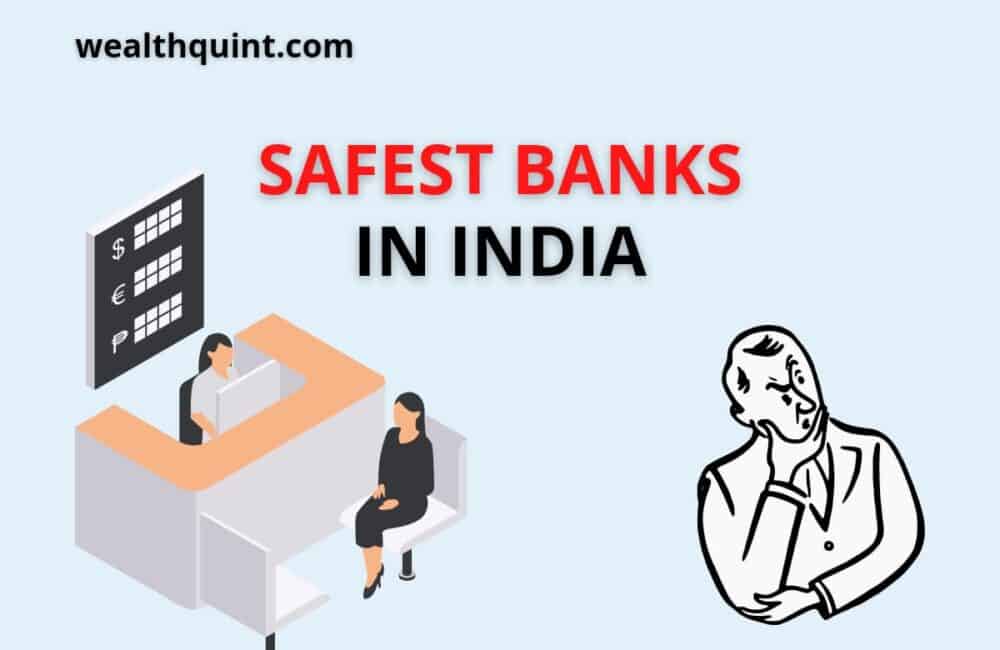In this article, you will learn about the safest banks in India where you can save your hard-earned money.
Following are the parameters and the features of the safest bank.
- A bank with a user-friendly reputation and can tolerate even the economic slowdown in the country.
- The maximum number of branches with a long history.
- Maximum number of ATMs across the country.
- The bank should provide great and convenient services to the customers.
- The bank can distribute loans.
List Of Top 10 Safest Banks In India
Every bank in this list has some unique specializations and features that make them strong, safe, and different.
1. State Bank Of India (SBI)
The State bank of India can be one of the most trustworthy banks as the Indian government and some shareholders run it. The SBI was established in 1955, which shows it has a long history of serving customers in India.
How Is SBI Bank Safe?
- The bank takes full responsibility for your assets.
- If any mishappening occurs with the bank, SBI compensates its customers.
- SBI has a 128-bit SSL encryption system that ensures your data is secure. So that no one can scramble it.
- It is also among the top 100 banks in the world. Its m-cap ratio is even higher than any private sector bank.
2. HDFC Bank
The term HDFC stands for the Housing Development Finance Corporation. A private bank established in 1994 is the largest private bank of India in terms of its assets. The headquarter of the bank is located in Mumbai. Recently, this bank has got a Forbes ranking of 77th in terms of best employers globally.
How HDFC Is The Safest Bank?
- HDFC regularly keeps updating its security features like intrusion detection and prevention system, firewall, and anti-malware.
- If you are using its online banking service, the webpage of HDFC is fully secured.
- To resist any misuse, its login page automatically signs out after a certain period.
- The net NPA (Non-performing assets) HDFC (0.5) ratio is very low among the other banks in India.
3. Punjab National Bank (PNB)
The PNB stands for Punjab national bank. The bank has more than a hundred years of running history, which implies its credibility in offering financial and banking services worldwide. PNB was established in 1894, and this bank is the second-largest bank after the state bank of India. PNB facilitates its customers to open online bank accounts and use other banking services.
Factors That Make PNB; The Safest Bank
- PNB has all the security features like an anti-malware and 128-bit SSL data encryption system, ensuring your hard-earned money to be safe from hackers.
- Punjab national bank is a PSU bank that runs directly under the Indian central government, which increases its credibility and trust.
- There are seven other banks that have been merged in Punjab national bank in its operational history. Oriental bank of commerce and the united bank of India are the latest two names that have been swallowed by the PNB, which denotes that it is a credible and efficient bank in the market.
4. ICICI Bank
A multinational private bank has been known for providing financial support in India since the year 1994. Its headquarters is located in Vadodara, Gujrat. The bank will have total assets of 1,573,812 crores (US$210 billion) in 2021.
How Safe Is The ICICI Bank?
- ICICI bank has a great risk management system in terms of its operations.
- This bank understands, monitors, and keeps measuring certain parameters to avoid any financial risks at their level.
- The gross non-performing assets are comparatively from the last five years, which is a good indicator of a healthy bank.
- ICICI has a good return on assets which is 1.68. However, banks having lower or negative ROA ratios implies that the bank has failed to utilize its assets efficiently.
- The good provisioning coverage ratio of ICICI (87.5%) indicated it is one of the safest banks in India.
5. Bank Of Baroda
This bank is run by the ministry of finance and the government of India. It was established in 1908. The bank has total assets of Rs 1,202,676 crore (US$160 billion) in 2021.
How Safe Is The Bank Of Baroda Bank?
- The credit deposit ratio of the Bank of Baroda has been uniform for the last four years.
- The provisioning ratio of the Bank of Baroda is 85.46%. It means the bank is not vulnerable in terms of maintaining the issues related to asset quality.
6. Axis Bank
India’s third-largest private bank was established in 1993. It is even older than the HDFC and ICICI bank. As per the report in 2021, the bank has accumulated assets of US$130 billion (1,010,325 crores).
How Safe Is Axis Bank?
- The Capital adequacy ratio of Axis bank is 18.2% which is a good sign for its depositors. It denotes that the bank can meet its obligations without affecting its customers.
- The provisioning coverage ratio of Axis bank has improved over the last three years. Above 70% of PCR ratio is regarded as an ideal. However, this bank has maintained 78%79% from the year 2019.
7. Kotak Mahindra Bank
KMB is one of the fastest-growing banks having assets of US$64 billion (Rs478,872 crore) in 2021. However, it was established in 2003, headquartered in Mumbai.
Why Is Kotak Mahindra The Safest Bank?
- Kotak Mahindra Bank has the highest CASA ratio among the other banks.
- The bank has a high net interest margin of about 4.69%.
- The capital adequacy ratio of Kotak Mahindra (18.2%) is higher, which means the bank can handle loss without diluting capital.
8. Canara Bank
Canara bank is one of the largest government banks ranked at fourth position in terms of network and assets (US$150 billion) in 2021. The headquarters is located in Bengaluru, established in 1906.
How Is Canara Bank Safe?
- The provision coverage ratio of Canara Bank is 79.68% in the year 2021.
- The capital adequacy ratio (CAR) of Canara bank is 13.18 % till March 2021, which is a good indication for its business.
9. Bank Of India
Bank of India was initially established as a private bank, but later on, it was undertaken by the government of India. It has total assets of US$96 billion (725,856.45 crores) in 2021.
What Makes The Bank Of India Safe?
- The provisional coverage ratio of the Bank of India is 86.24% which can be considered as one of the highest ratios.
- The CAR (Capital Adequacy Ratio) of the Bank of India is higher than the regulatory requirement. It means the bank has the potential to overcome any unexpected losses. The required percentage is 10.875. However, the bank has a CAR of 14.19%.
10. Union Bank Of India
UBI is also among the oldest banks, which has 101 years of track record of providing service from urban to rural areas. It is a government bank that has assets of about US$140 billion (Rs 1,071,705 crore) in 2021.
How Safe Is The Union Bank?
- The PCR (Provision coverage ratio) of Union Bank is from the last year. It was 78.21% in the last year. However, it has improved to 81.27% as of March 31, 2021, which may be considered a good indicator.
- Union Bank of India has one of the most secured and safe environments in terms of online transactions, evidenced by “VERISIGN” – a digital certificate that marks the bank for the safest and secured online transactions.
To Sum Up
SBI, HDFC, PNB, ICICI banks are the safest banks in India followed by Bank of Baroda, Axis Bank, Kotak Mahindra Bank, Canara Bank, Bank of India, Union Bank of India where you can save your money without scarring of loss as they are well established with good assets and long service history. They also provide a safe and secure environment for online transactions that you can do without any fear.
Recommended:
List of Private Banks in India
List of Foreign Banks in India



